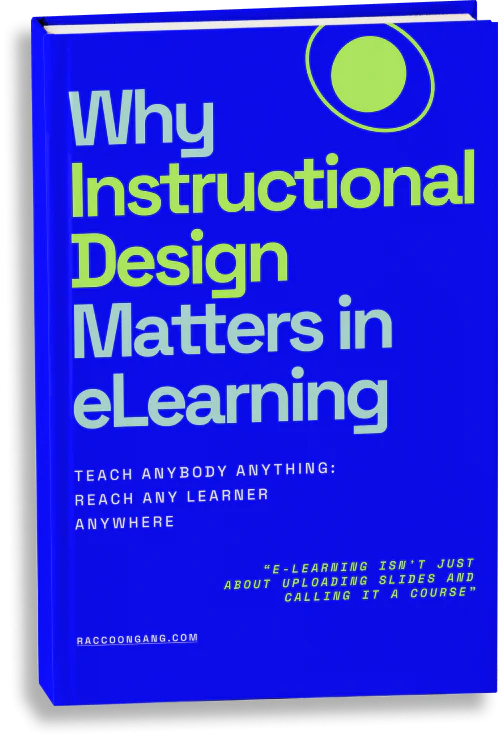Interactive online learning creates a two-way dialogue between the learner and content, requiring active participation, choice-driven scenarios, and instant feedback.
Interactive online learning entails going beyond the passive one-way nodes of reading, listening, and watching static content. It includes pulling out the exact content you want and manipulating it, rather than just waiting for information and digesting it. Having said that, it’s important to understand these four concepts to grasp what interactive online learning is all about.
- Not Interactive. This content remains unresponsive; clicking “next” feels no different from using a TV remote or turning book pages. If the slides fail to sense learners’ needs and address them, they remain “not interactive.”
- Reactive. With hyperlinks and multiple-choice questions, learners follow preset branches that loop back in a linear path. This prescriptive approach grants limited control, since the content only reacts within its programmed expectations.
- Interactive. Genuine interaction comes when content responds to both explicit queries and implied needs. Examples include video games, high-fidelity simulations, immersive tutorials, and problem sets—every variable adapts to learner behavior at each step, offering immediate feedback.
- Interactive Plus. This top tier supports group interaction and experiential learning; multiplayer games, collaborative simulations, and live distance sessions let one learner’s choices affect others. The system senses everyone’s actions and responds collectively, mirroring real social ecologies.
“We integrate interactivity into all courses on Open edX, from click-and-reveal to scenarios with adaptive logic,” notes a Raccoon Gang EdTech Engineer.
Both Interactive and Interactive Plus content promote engagement and active learning. Many still equate “interaction” with simple clicks, but true interactive online learning demands rich two-way engagement, choice pathways, and on-the-spot feedback.
Key Principles of Interactive Learning
Interactive online learning doesn’t happen by accident. It’s a result of a systematic, planned development process. Before creating an eLearning course, an expert also needs to be aware of the principles of online learning. There are certain patterns in which people process information.
Each principle of interactive online learning should align with a type of communication or activity that facilitates the process of eLearning. This way, chances for learners to interact should be higher and they should be more likely to retain the information and skills they obtain.
We’ll now take a look at some key principles that will help you structure a training session that provides the best possible learning experience to your learners.
Set the Stage for Effective Online Learning
Try to engage the learner from the very beginning by taking a strong start and setting the stage for an amazing learning experience. To disengage the learner from all other tasks and divert their full attention to your course, open your eLearning module with an interesting activity or introduction. Some great strategies to capture learners’ attention at the start of the course include:
-
Asking a thought-provoking or a short survey question
-
Sharing an unpredicted, insightful, statistic or fact
-
Using an activity that engages learners in the learning process
-
Using a fascinating introductory video clip
Incorporating interactive online learning elements, such as engaging simulations or branching scenarios, can significantly increase learner engagement right from the start.
Communicate Online Learning Objectives Upfront
Stating objectives clarifies to the learners ‘What’s in it for me?’ Not only does this set expectations for your learners for what lies ahead but also conveys the value the course offers. You can simply list the objectives in a slide. Ideally, you should also state the expected performance standard, the required performance, and what a successful outcome would look like.
Link the Content with Learners’ Existing Skills or Knowledge
Helping your learners recall prior learning gives them a sense of confidence as they approach new material. The best way to stimulate this recall is to conduct a test to check how much they remember. Alternatively, you can simply add a summary of the concepts or knowledge they have learned until now.
eLearning applications typically come with useful knowledge check tools, allowing you to create different types of test questions including MCQs, matching, fill-in-the-blanks, etc.
Utilize Visuals and Structure the Content Well
When delivering new information, knowledge, and skills to your learners, leverage images, graphics, tables, and graphs instead of relying on text. This should help learners visualize and properly understand each concept. To make sure that the information doesn’t overwhelm the learners, organize and sequence your content in a reasonable way that facilitates information absorption.
Using a training video or video course is an incredible way to do this. You may also choose to create a slide-based course. The best eLearning programs allow you to build or create any of these.
Use Tools that Facilitate Online Learning
Learning content is one thing, but there are various ways to support the learners on how they can learn and develop skills. This can be as simple as providing useful hints or tips, offering advice on content learning, guiding them through available learning resources, and giving real-life examples.
Other supportive objects that can assist in learning include concept maps, infographics, case studies, job aids, etc., that can be included in the eLearning program.
Put the Acquired Knowledge to Use
When you know that a learner can demonstrate the knowledge or skills they’ve acquired from the training content, it’s time to be practical. While the entire course should be interactive, this is where the learners will be engaged the most. The interactive elements you use at this stage should require them to apply their acquired knowledge or skills.
Among the most effective ways is to use dialog simulation through a realistic work-related scenario, in which the outcomes vary depending on the learner’s response to each question.
Provide Immediate Feedback
After a learner applies their knowledge or skills, provide feedback spontaneously. If the learner performed well, sharing a positive comment should reinforce the right things they’re doing. For any skill or knowledge errors, sharing constructive, helpful advice should help learners identify what exactly they did wrong.
Set a suitable comment for every answer the learners might choose in the dialog simulation, for instance. To point out a mistake the learner made as well as to explain the correct course of action, or even praise them for doing the right thing, you can even create information scenes that will prove more appealing for them.
Conduct Assessments
Once the learners have gone through all content of an online course, assess them through comprehensive quizzes or tests. Interactive online learning programs offer highly customizable testing solutions, such as exciting drag-and-drop questions, cause-and-effect matching, and more.
Hence, depending on the nature of your business, you get different types of questions to choose from.
Facilitate Knowledge Retention and Transfer
Finally, there has to be some way to improve knowledge retention and transfer. What you can do is share valuable resources, such as instruction manuals, catalogs, working guides, etc., that the learners can refer to at any time to recall things they’ve learned. The top online learning solutions can even help make the reference materials highly interactive.
To build interactive-rich courses that last, be sure to review our article on instructional design principles, which offers a comprehensive look at foundational design rules.
Benefits of Interactive Online Learning (NEW block)
When weighing the benefits of interactive online learning, you’ll notice concrete lifts in engagement metrics, memory retention, and learner satisfaction.
- Increased Engagement. Imagine decision-driven scenarios where every click alters the narrative, like a virtual safety walkthrough that stops at each hazard point and demands a choice, then immediately adapts. Organizations report a 60 percent drop in dropout rates when learners face interactive quizzes instead of static videos; analytics heatmaps even pinpoint the exact moments when attention peaks.
- Improved Memorability. Embedding adaptive flashcards and spaced-repetition tasks after short micro-lessons captures the core benefits of interactive online learning, boosting recall by up to 40 percent versus one-off lectures. A GDPR compliance module, for example, might follow a brief animation with a drag-and-drop exercise; this combination of visual learning and active retrieval locks facts into long-term memory.
- Better User Experience. Real-time dashboards update as learners progress through branching paths, handing them control of their journey. Add mobile-first features—offline caching of interactive elements, push reminders for missed checkpoints—and satisfaction scores jump nearly 25 percent. Each seamless interaction feels intuitive and rewarding, making training feel less like a chore and more like exploration.
To obtain a better idea about how these principles can be applied to online learning, study the following examples:
Examples of Interactive Online Learning Tools
Stories
The power of stories is tremendous, and you can recall every single detail of it. That’s why stories have become an incredible tool in eLearning solutions. From start to finish, deliver your content in a story-like manner, where the characters are relevant to the industry and learners. Consider incorporating appropriate dialogs and the right morals. Here are some examples of story-based eLearning modules:
Character Dialog: This is an interesting interaction that unfolds your story through a conversation between illustrated objects or characters.
3D eBook: Unlike a traditional eBook that only includes text to narrate a story, this 3D eBook makes use of images and text to make the story-based content more interactive for learners.
Simulations and Scenarios
These include activities designed to take learners to real-life, virtual situations without requiring them to face them or their consequences in reality. Interactive online learning techniques like simulations provide a safe and engaging way for learners to develop skills and knowledge. Examples of these include:
Role-Based Individualized Simulation: This type of simulation puts the learner in specific situations and requires them to act as a decision-maker or a problem solver. As they go about reacting to each situation, you make sure they’re aware of the complicated aspects of each question using instructive feedback.
Goal-Driven Immersive Learning Situation: This serves as a scenario template that gives the learners an interactive tour of the process, a real-life scenario, or a concept using hotspots. The solution empowers the learners to choose their learning path, making it a great example of interactive online learning. Instructive feedback can be given for the choices they make to reinforce the learning objectives.
Museum Simulation: This interaction involves giving the learners a 3D walk-through of a virtual museum that contains up to four sections, which may feature videos and images to enhance interactive online learning experiences.
Games
Games add an element of fun, which is an effective driver for human beings. Given that you utilize the right game mechanics such as levels, points, leaderboards, badges, etc., the engagement levels of your eLearning gamification can soar significantly. Let’s take a look at some examples of gamification in online learning.
Slot Machine: Based on the theory of positive reinforcement, this game is highly effective to motivate learners.
Audio-Visual Crossword: Based on a common game played around the world, the audio-visual crossword includes clues in the form of images or audios to help learners recall the correct word.
Tic-Tac-Toe with Questions: We’ve all played this game at some point in our childhood. Most learners should relate to this game, which can be used to reinforce the most important concepts.
Spin the Wheel: This is probably the most recognized game around the world. In an assessment, a diverse variety of questions can be assigned to the wheel. Learners are asked questions about the category on which the spinning wheel stops.
Assessments and Quizzes
Oftentimes, these two terms are used interchangeably. However, they are somewhat different. An assessment is a more formal standard evaluation method, while a quiz is typically shorter, relatively informal, and doesn’t usually have a major impact on learners’ overall scores. Yet, both effectively help learners identify their areas of improvement. Among the most common examples include:
Million Dollar Quiz: This is a good transformation to the traditional MCQ-based questions. Million-dollar quizzes test the knowledge of learners in a fun way, using money as the driver for learners.
Visual Assessment: Visual assessments take the learners through scenarios or stories before questioning and testing them. With this assessment, you can use multimedia elements, including a visual introductory screen and some audio-visual questions.
Conclusion
By 2025, interactive online learning has morphed into an everyday expectation rather than a fancy add-on, with learners demanding two-way dialogues, scenario pivots and instantaneous feedback on phones, tablets and desktops alike. Static slides and linear videos? They feel flat now; genuine interaction sparks focused attention, cements concepts through hands-on practice and breathes life into training so it grows and shifts as fast as your audience does. With attention spans contracting and mobile sessions surging, you need responsive quizzes, branching simulations and peer-to-peer exercises woven into every lesson—anything less feels obsolete.
Join forces with Raccoon Gang to infuse interactive online learning into your Open edX or mobile app. We’ll sketch your learner’s path, craft engaging modules and deliver experiences that stick—book your call today.
FAQ
What is interactive online learning?
Interactive online learning turns passive study into a two-way exchange, where learners make choices and receive immediate feedback. It blends scenario-driven tasks, quizzes, and simulations to adapt content on the fly based on user inputs.
What are examples of interactive learning tools?
Branching video scenarios that change based on your answers and drag-and-drop exercises for process mapping are classic examples. High-fidelity simulations—like virtual labs—and real-time polls during live sessions also count as interactive learning tools.
How do interactive courses improve engagement?
By requiring learners to make decisions and see the consequences instantly, interactive courses create a sense of ownership over the material. This active participation reduces drop-off rates and increases knowledge retention compared to linear slide decks.
What platforms support interactive learning?
Many modern LMSs, such as Docebo and TalentLMS, offer built-in authoring or XBlock support for interactive elements. Specialized platforms like Articulate Rise or H5P can also be plugged into broader systems to deliver quizzes, dialog simulations, and click-to-reveal content.
Does Raccoon Gang build custom interactive content?
Yes—Raccoon Gang crafts bespoke interactive learning experiences, from scenario-based modules to adaptive quizzes, tailored to each client’s workflow. We layer logic and multimedia into Open edX courses and mobile apps to match your brand and training goals.
Can interactive modules be integrated into Open edX?
Absolutely. Open edX’s XBlock architecture lets you embed custom interactions—such as drag-and-drop, video branching, or feedback loops—directly into course pages. Raccoon Gang’s development team handles the end-to-end integration and testing for a seamless learner experience.
-
Key Principles of Interactive Learning
- Set the Stage for Effective Online Learning
- Communicate Online Learning Objectives Upfront
- Link the Content with Learners’ Existing Skills or Knowledge
- Utilize Visuals and Structure the Content Well
- Use Tools that Facilitate Online Learning
- Put the Acquired Knowledge to Use
- Provide Immediate Feedback
- Conduct Assessments
- Facilitate Knowledge Retention and Transfer
- Benefits of Interactive Online Learning (NEW block)
- Examples of Interactive Online Learning Tools
- Conclusion





